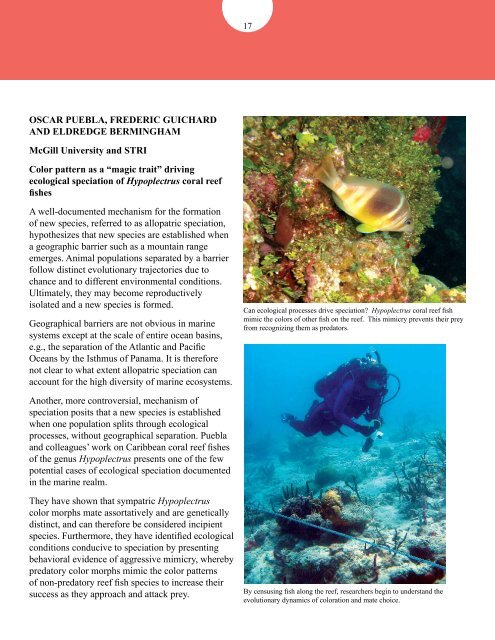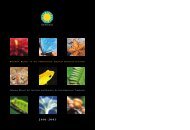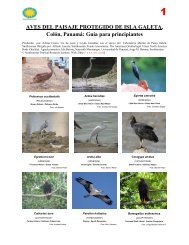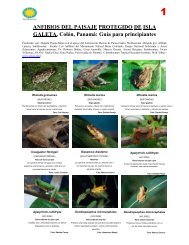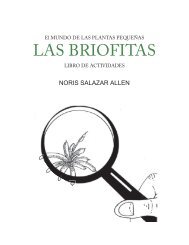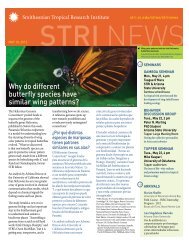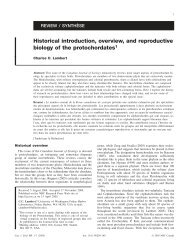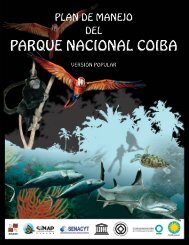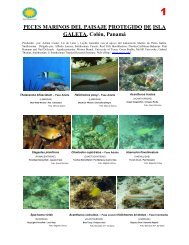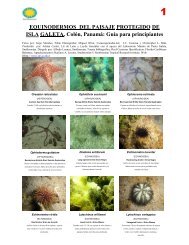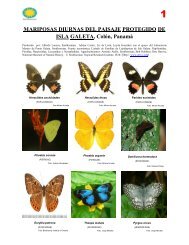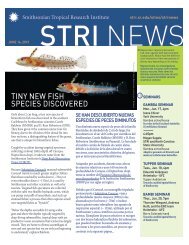Bocas del Toro Research Station - Smithsonian Tropical Research ...
Bocas del Toro Research Station - Smithsonian Tropical Research ...
Bocas del Toro Research Station - Smithsonian Tropical Research ...
You also want an ePaper? Increase the reach of your titles
YUMPU automatically turns print PDFs into web optimized ePapers that Google loves.
OSCAR PUEBLA, FREDERIC GUICHARD<br />
AND ELDREDGE BERMINGHAM<br />
McGill University and STRI<br />
Color pattern as a “magic trait” driving<br />
ecological speciation of Hypoplectrus coral reef<br />
fishes<br />
A well-documented mechanism for the formation<br />
of new species, referred to as allopatric speciation,<br />
hypothesizes that new species are established when<br />
a geographic barrier such as a mountain range<br />
emerges. Animal populations separated by a barrier<br />
follow distinct evolutionary trajectories due to<br />
chance and to different environmental conditions.<br />
Ultimately, they may become reproductively<br />
isolated and a new species is formed.<br />
Geographical barriers are not obvious in marine<br />
systems except at the scale of entire ocean basins,<br />
e.g., the separation of the Atlantic and Pacific<br />
Oceans by the Isthmus of Panama. It is therefore<br />
not clear to what extent allopatric speciation can<br />
account for the high diversity of marine ecosystems.<br />
Another, more controversial, mechanism of<br />
speciation posits that a new species is established<br />
when one population splits through ecological<br />
processes, without geographical separation. Puebla<br />
and colleagues’ work on Caribbean coral reef fishes<br />
of the genus Hypoplectrus presents one of the few<br />
potential cases of ecological speciation documented<br />
in the marine realm.<br />
They have shown that sympatric Hypoplectrus<br />
color morphs mate assortatively and are genetically<br />
distinct, and can therefore be considered incipient<br />
species. Furthermore, they have identified ecological<br />
conditions conducive to speciation by presenting<br />
behavioral evidence of aggressive mimicry, whereby<br />
predatory color morphs mimic the color patterns<br />
of non-predatory reef fish species to increase their<br />
success as they approach and attack prey.<br />
17<br />
Can ecological processes drive speciation? Hypoplectrus coral reef fish<br />
mimic the colors of other fish on the reef. This mimicry prevents their prey<br />
from recognizing them as predators.<br />
By censusing fish along the reef, researchers begin to understand the<br />
evolutionary dynamics of coloration and mate choice.


